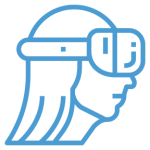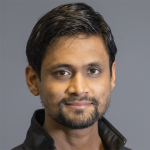Research Area: Human Computer Interaction
 Human-Computer Interaction
Human-Computer Interaction
Within the area of Human-Computer Interaction, UNC’s main focus is on developing immersive 3D interaction systems. This includes head-mounted displays that lets our collaborators walk around inside their molecular data, ship designs, and architecture.
Subareas: Assistive Technology, Haptics, Human Factors Analysis, Sound & Audio Display, User-Interface Toolkits, Virtual Environments
It also includes force-feedback systems that let our collaborators touch molecules, feel the brush interacting with the canvas for virtual painting, and feel the 3D models they are sculpting. It also includes the real-time generation of physically-based surround sound to enable designers to hear how a space will sound and to improve the realism and engagement of game play. Our focus on making complete tools for our collaborators continues to push us to develop both software, hardware (graphics engines, trackers, hand-held interaction devices), and new interaction techniques to meet their needs.
Wearable devices, such as smart watches and smart glasses, and other common sensors are increasingly facilitating new modes of interaction with modern computers—making the goal of ubiquitous computing realizable. A major research direction in HCI at UNC is exploring design techniques and system support to more easily extend desktop and phone applications onto devices with widely varying form factors and interaction modes.
Another significant research direction at UNC is exploring assistive technologies for users with impairments, such as learning disabilities, blindness, and low vision. These populations face significant barriers to education and employment that we aim to reduce, as well as study different modes of interaction with computers.
UNC also undertakes projects in computer-supported collaborative work, challenging the traditional paradigm of one user on one computer and enabling distributed users to simultaneously communicate with a program to collaborate with each other.
Faculty

Praneeth Chakravarthula
Assistant Professor

Prasun Dewan
Professor

Henry Fuchs
Federico Gil Distinguished Professor

Alyssa Lytle
Teaching Assistant Professor

Richard Marks
Professor of the Practice

Shahriar Nirjon
Associate Professor

Donald Porter
Professor

Diane Pozefsky
Research Professor

Shashank Srivastava
Assistant Professor

David Stotts
Professor

Daniel Szafir
Associate Professor

Mary C. Whitton
Research Professor
If you need assistance contacting a faculty member, please email the External Relations team.
Research Groups
Research Groups will be added here.
